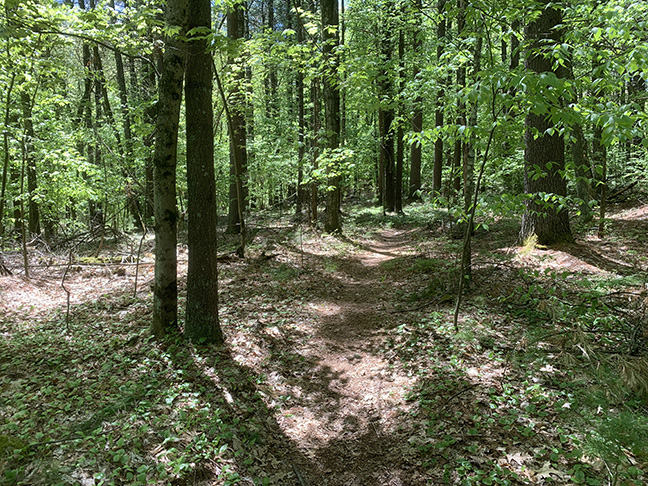The Conservation Commission at its meeting Tuesday night continued hearings on two cases it has been considering for several months: the Massachusetts Laborers Training Center property at 37 East Street and The Trails development.
These were the two main cases under discussion in a 2 1/2-hour meeting. The hearing room at the Hopkinton Senior Center was packed with at least 20 audience members, several of whom said they were abutters to the Massachusetts Laborers Training facility who were not clearly notified about a potential gas line proposed near their property lines. The installation of the gas line would involve site work on the Clinton Street right of way from Front Street as well as between 66 and 82 Clinton Street, which the commission discussed at the previous meeting.
Attorney George Connors represented the applicant on the four notice of intent (NOI) hearings regarding the property. The hearing regarding the pond dredging near the dormitory was swiftly continued when Connors explained that the water quality was determined to be poor.
The gas line hearing was the most contentious and the main focus of debate for more than an hour. Connors said that an alternative gas line proposed that would go down Clinton Street to East Street would be 2,600 additional feet on Clinton Street as compared to the first plan proposed. His preferred plan was to cross a wetland area and continue across the campus around the pond to the dormitory building. Numerous trees would be cut in the process.
The gas line installation, Connors said, would require an easement for a corridor that would be between 20-25 feet wide for the pipe installation, a trench and the staging area. The contractors disagreed, he noted.
“They really want a wider easement,” he said. “They want 35 feet. But we’ve talked to them. And we’ve kept it to 25 in the resource areas.”
Connors again repeatedly pushed for the approval of the Clinton Street portion of the work on the original plan because the construction season would be ending with winter approaching. But chair Jeff Barnes said the commission would not be pressured, noting the previous continuation requests by Connors on the project over nearly a year’s time. This plan submitted two weeks prior was dated in July, and there was not sufficient time for review by the town’s environmental consultant, Lucas Engineering, he said.
“I’m still a little bit frustrated that a 25-foot swath of corridor needs to be installed for the installation of these small utility lines,” Barnes said, noting that “there is plenty of room for staging areas on site.”
“It’s laborers’ training, and this is what you guys do for work all the time,” he continued, noting that it wasn’t a landscaping company. “My comment would be: What’s wrong with Clinton Street?”
Connors cited the cost of directional drilling at that site of between $40,000 and $50,000, making it “economically unfeasible.”
“Unfortunately, you know, the commission doesn’t take into account the financial implications of projects,” Barnes said. “We take into account the resource area disturbance. I think a lot more work needs to be done, in my mind, to pare back.”
Residents advocated for the gas line installation at Clinton Street and East Street, noting that they would be able to connect to the gas line and discontinue the use of oil. Several commented on losing forest in order for the applicant to save money. Also, wildlife would enter their yards even more so than it does currently, they said. They also said they were alerted about the pipeline potentially abutting their properties only when they saw surveyors.
Abutter Bruce Brubaker noted that Connors mentioned that the entire project costs $60 million, while Connors appeared to object to the additional expense of about $50,000 to have the gas line go down Clinton Street. Connors countered that the number given was “an example” and didn’t include directional drilling and other costs.
If the gas line were to go further down Clinton Street to allow future customers to connect, a 4-inch pipeline might not be adequate, Barnes added.
This hearing was continued until the next meeting on Dec. 6.
More information requested for The Trails
The commission also continued hearings on proposed drainage improvements at The Trails, a development off Legacy Farms North Road.
Project engineer Peter Bemis explained that one hearing involved work to be done in Hopkinton to rectify previous drainage issues that impacted the town of Ashland. He noted that “at some point” Ashland did work on a Hopkinton road without realizing that it was within Hopkinton’s boundaries in an emergency situation. A proposed depression would allow the water to be directed into a box culvert.
He said he didn’t expect a decision that evening but wanted to alert the commission that work would need to be done within the buffer zone to divert the water.
The other hearing involved proposed improvements to the detention basins for the second, third and fourth phases of The Trails, Bemis said. Originally designed for half-inch filtration to contain rooftop runoff, Beamis proposed expanding them for 1-inch filtration.
Barnes asked that the water be directed into dry wells. That wouldn’t work, according to Bemis, because of the impermeable soil there.
“The concern is the runoff from the site,” Barnes explained, “and that it’s not being properly maintained.”
Conservation Administrator Kim Ciaramicoli noted that Bemis has failed to provide requested information to engineering consultant BETA Group on watershed plans, riprap and details from a hydrogeologist, among other concerns. Some answers provided were vague, she said.
“It just seemed like there were so many items that didn’t get done,” she said.
This placed the project “in a holding pattern,” according to Barnes, until that is done.
Regarding the Ashland situation, Barnes said that he wanted to work with Bemis “in good faith,” but the information needs to be complete.
“This back and forth is killing me, to be honest with you,” Barnes said. “These oversights get frustrating, from our perspective.”















0 Comments